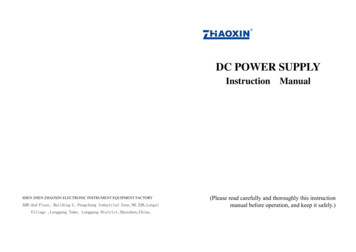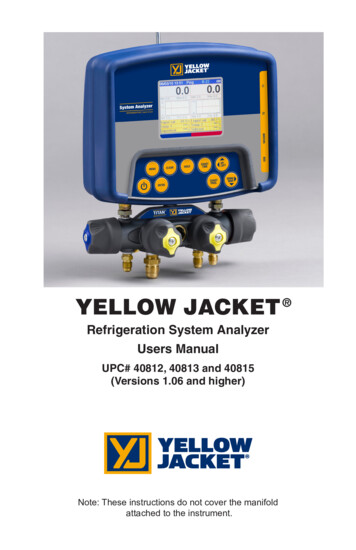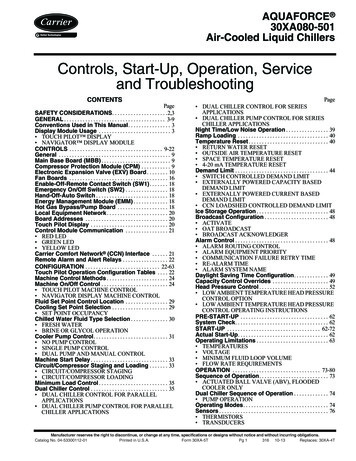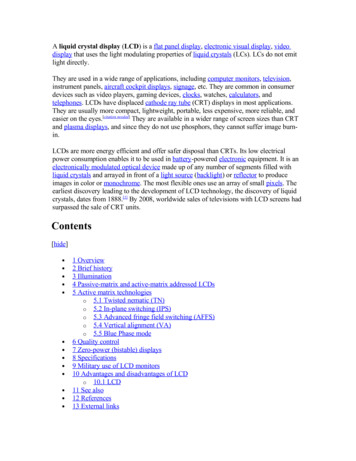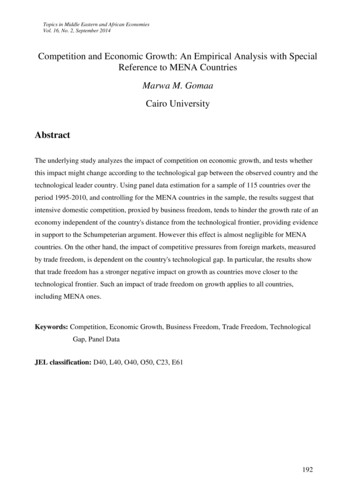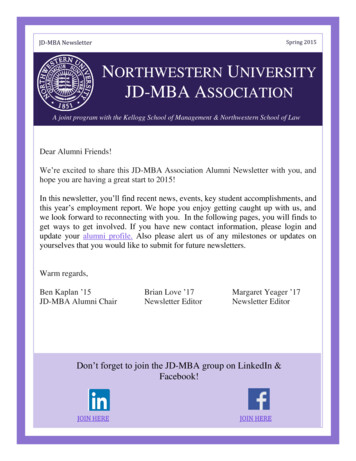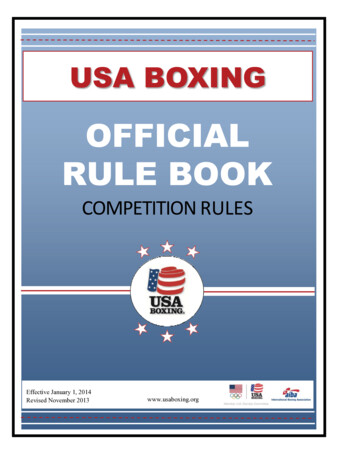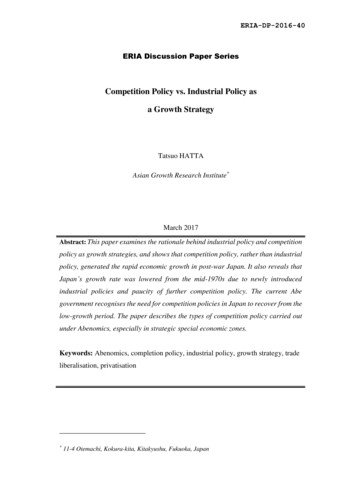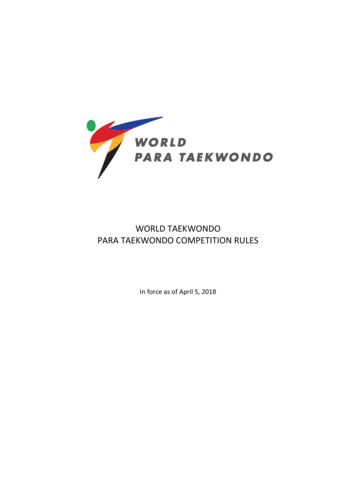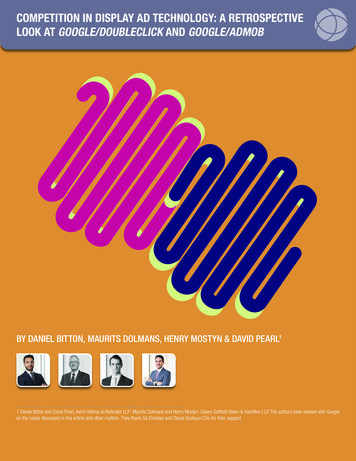
Transcription
COMPETITION IN DISPLAY AD TECHNOLOGY: A RETROSPECTIVELOOK AT GOOGLE/DOUBLECLICK AND GOOGLE/ADMOBBY DANIEL BITTON, MAURITS DOLMANS, HENRY MOSTYN & DAVID PEARL11 Daniel Bitton and David Pearl, Axinn Veltrop & Harkrider LLP; Maurits Dolmans and Henry Mostyn, Cleary Gottlieb Steen & Hamilton LLP. The authors have worked with Googleon the cases discussed in this article and other matters. They thank Tal Elmatad and Stacie Soohyun Cho for their support.
CPI ANTITRUST CHRONICLEAPRIL 2019Big Data and Online Advertising: EmergingCompetition ConcernsBy Hon. Katherine B. Forrest (fmr.)Public Goods, Private Information: Providing anInteresting InternetBy J. Howard Beales IIIWhat Times-Picayune Tells Us About theAntitrust Analysis of Attention PlatformsBy David S. EvansOnline Advertising and Antitrust: NetworkEffects, Switching Costs, and Data as anEssential FacilityBy Catherine E. TuckerAttention Oligopoly: Comments on the Paper byPrat & VallettiBy David Parker & Federico BruniCompetition in Display Ad Technology: ARetrospective Look at Google/Doubleclick andGoogle/AdmobBy Dan Bitton, David Pearl, Maurits Dolmans& Henry MostynAdvertising as Monopolization in theInformation AgeBy Ramsi A. WoodcockA New Digital Social Contract to EncourageInternet CompetitionBy Dipayan GhoshFrom Demoting To Squashing? CompetitiveIssues Related to Algorithmic Corrections: AnApplication to the Search Advertising SectorBy Frédéric MartyVisit www.competitionpolicyinternational.com foraccess to these articles and more!I. INTRODUCTIONAs part of sector inquiries into digital platforms or online advertising, someenforcement agencies are considering evaluating competition in onlinedisplay advertising and display advertising technology or intermediationservices (“ad tech”). Recently, some commentators in this industry havealso published about it.2This is not the first time enforcement agencies have looked at thissector of the economy. They have scrutinized this space in the review of anumber of mergers, each time without seeking enforcement. A careful review of competitive indicia shows that display advertising and ad tech bearall the hallmarks of a highly competitive and innovative space. Technicaldevelopments that increase ad conversion rates suggest an increase inefficiency — and an intensification of competition. This disruption affectsincumbents, but that is not in itself an indication of a lack of competition. Tothe contrary, that typically is indicative of increased competition.In this article, we seek to demystify the complex online advertisingecosystem and to correct some common misconceptions about it. We willalso look back at past mergers and acquisitions in the space and reviewhow the market subsequently evolved.II. OVERVIEW OF ONLINE DISPLAYADVERTISING AND AD TECHMany publishers, especially those online, operate as “two-sided” platforms, in that they offer content or services to consumers (e.g. news,sports, photos, many types of search results, or social networking) whileselling advertising space to advertisers. Online display advertising is one ofmany formats that publishers can offer advertisers (i.e. selling advertisingspace on websites or in mobile applications). The term display advertisingis typically used to refer to a category including various forms of onlineadvertising, including text, image, and video ads.Traditionally, some have characterized display ads and search adsas serving different purposes for advertisers. The idea was that advertisers employed display ads to create brand awareness and search adsto trigger a direct response (e.g. a sale). The rationale for this distinctionwas as follows: search ads are targeted to users who, by having entered asearch query for particular product, have demonstrated an interest in thatproduct and are thus likely candidates to purchase it. Traditional display“banner ads” on a website were less targeted to likely buyers than searchads, since they appeared to all visitors to that website regardless of theirinterest in the advertised products. These display ads were better suitedfor building up brand recognition, much like traditional ads in newspapers,2 See, e.g. D. Geradin & D. Katsifis, An EU Competition law Analysis of Online DisplayAdvertising in the Programmatic Age, SSRN (Dec. 12, 2018), https://papers.ssrn.com/sol3/papers.cfm?abstract id 3299931.CPI Antitrust Chronicle April ion Policy International, Inc. 2019 Copying, reprinting, or distributingthis article is forbidden by anyone other than the publisher or author.2
in magazines, or on TV.3This distinction, while an understandable shorthand some time ago, is anachronistic and does not hold today. Due to the emergence ofadvanced targeting technologies,4 most display ads are now also targeted or personalized to particular users or groups based on the contentof the website or mobile app on which the ad is displayed, a user’s prior web browsing activity, or information about their interests, location,or demographics. As a result, from an advertiser’s perspective, display ads are often interchangeable with search ads and can be even moreeffectively targeted.5The emergence of marketing mix optimization tools has also contributed to a blurring of the lines between, and competition between,different ad formats. Advertisers use these tools to compare the price and performance of different ad platforms, formats, and channels in real-time and to shift their ad spend among them to optimize their return on ad spend.6 Notably, marketing mix optimization tools not only enableoptimization across different online ad formats and channels but also between online and offline advertising formats. That, combined with theemergence of targeting technologies for offline formats, has further broken down traditional distinctions between different types of advertising.As an example, Amazon’s emergence as a major player in online advertising drew advertising spend from other online marketplaces, searchadvertising platforms, social media, display ads, TV, radio, outdoor advertising, and print.7This all marks a substantial evolution in the ad tech industry. In the early days of online advertising, the placement of ads was largely amanual process. The advertiser would negotiate directly with the web publisher to purchase specific ad space for a particular price and particularduration. The advertiser would then email the ad creative to the publisher and the publisher would manually place the ad on its website.As the supply of ad inventory on the internet grew exponentially, it was no longer feasible to handle all placements manually. Ad tech firstemerged as a means to more efficiently place ads, and then evolved to render the entire process of purchasing and selling of ads more efficient.This creates monetization opportunities for countless small web publishers and unlocked a lot of ad inventory that had previously gone unsold,thereby expanding the pie for all. It also created many more opportunities for advertisers, especially smaller advertisers. While as much as halfof online ad revenue today is still generated through direct sales (even these sales often rely on ad tech for the actual placement of the ad), theother half is done through ad tech.8 We next describe the most common elements in the “ad tech stack,” depicted in the chart below.3 Matt Schruers, Infographic: How Ad Dollars Are Spent, Disruptive Competition Project (Jan. 16, 2018) w-ad-dollars-arespent/#.XEtwmdJKiUk (“Consider today’s reality: advertisers compete to reach the same consumers across multiple mediums. Services that deliver ads digitally to an individual’smobile device don’t just compete against one another; they compete directly with television, print and outdoor options (e.g. highway billboards, subway stations, Times Squareinstallations).”). According to this source, only 41 percent of a typical company’s ad spend is spent on digital advertising.4 Direct-Response Tactics Take Majority of US Marketers’ Budgets, eMarketer (May 20, 2014), 2 (“As marketers get better at measurement and attribution, the lines between direct-response spending and branding are blurring more than ever.In fact, eMarketer adjusted our methodology [in 2014], no longer defining direct-response and branding-focused advertisements based on specific digital ad formats (searchvs. display, for instance).”).5 Why You Should Bet on Pinterest, Ad Week (July 25, 2018), on-pinterest/.6 See, e.g. Adobe Media Optimizer is now Adobe Advertising Cloud, Adobe, mizer.html (“Our programmatic ad buyingsolution is evolving to further support your media planning and execution. It unites search, display, social, and TV into a single platform so you can find the best way toconsistently deliver audience-relevant content”); Marin Software, https://www.marinsoftware.com/; Kenshoo, https://kenshoo.com/. See also Bain Insights, The Future ofMarketing Mix Optimization is Here, Forbes (Feb. 28, 2018), e/#585a3af71387.7 See Ginny Marvin, 80% of Amazon advertisers plan to increase budgets in 2019, Search Engine Land (Oct. 25, 2018), plan-to-increase-budgets-in-2019-250489.8 Jacob Rosenzweig et al., A Guaranteed Opportunity in Programmatic Advertising, Boston Consulting Group (Feb. 7, 2018), teed-opportunity-programmatic-advertising.aspx. According to this study, 51 percent of 2017 global display and video ad spend was sold through traditional directarrangements as opposed to programmatic processes (which includes programmatic guaranteed). The share of traditional direct deals is expected to decrease but still accountfor more than 35 percent of display online advertising by 2020.CPI Antitrust Chronicle April ion Policy International, Inc. 2019 Copying, reprinting, or distributingthis article is forbidden by anyone other than the publisher or author.3
Ad servers are web servers that facilitate fully automated real-time ad placement through server-to-server communications betweenadvertisers and publishers. Advertiser-side ad servers also help with ad campaign management and performance tracking. Publisher-side adservers track ad performance and manage a publisher’s ad inventory. There are many popular advertiser-side ad servers (e.g. Adform, Adslot,Google Campaign Manager, Sizmek, Weborama, Innovid, Conversant, and Flashtalking) and publisher-side ad servers (e.g. MoPub (Twitter),Google Ad Manager, AppNexus (AT&T), SAS, and Adform.Ad networks were introduced to enable the sale and purchase of ad spaces that remained unfilled (generally slots on smaller or lowervalue websites). Ad networks aggregate such inventory and sell it to advertisers. This reduces search and transaction costs for advertisers andpublishers, thereby generating ad revenue for publishers where none previously existed. There are many competitive ad networks including InMobi, AdColony, Facebook Audience Network, Chartboost, Google’s Display Network and AdMob, Microsoft Audience Network, Unity Ads, Media.net, Flurry (Verizon), Vungle, AppLovin, and Fyber/HeyZap.Ad exchanges arose to help manage multiple ad networks competing for the same ad inventory by allowing ad buyers to bid simultaneously on the inventory of multiple publishers. There are many ad exchanges today including AppNexus, Google Ad Manager, PubMatic, RubiconProject, InMobi, MoPub, OpenX, RTL Group, Smaato, and Oath (Verizon).As competition increased, advertisers and publishers began to buy and sell ad inventory via multiple ad networks and exchanges simultaneously. Demand-side platforms (“DSPs”) and Supply-side platforms (“SSPs”) developed to help advertisers and publishers optimize their adpurchases and sales across intermediaries. There are numerous DSP and SSP options that advertisers and publishers can turn to, includingMediaMath, Amazon, Google’s Display & Video 360 and Ad Manager, The Trade Desk, TubeMogul (Adobe), Dataxu, AppNexus, Singtel’s Amobee,Oath, MoPub, InMobi, Rubicon Project, and PubMatic. Many DSPs also offer data management platforms to help advertisers and publishersdevelop valuable insights into user activity to improve audience targeting and thus ad quality and performance.Like the lines between different ad formats, the lines between ad tech solutions have blurred over time, such that advertisers and publishers can use some of them interchangeably. Moreover, vendors are increasingly offering multiple ad tech products that work together seamlessly.This dynamic online advertising ecosystem has been a boon to advertisers, publishers, and consumers alike. Advertisers have reapedenormous benefits from more effective technologies to target the desired audience, which in return enabled them to achieve much greater returnCPI Antitrust Chronicle April ion Policy International, Inc. 2019 Copying, reprinting, or distributingthis article is forbidden by anyone other than the publisher or author.4
on ad spend.9 Publishers have benefited from new and better ways to optimize monetization of their content and services. Both publishers andadvertisers engage in multi-homing (i.e. use of more than one ad tech provider for the same function), facilitating comparisons and switching.This, in turn, has benefited consumers by funding highly innovative, free-of-charge technologies and online content and more personalized andrelevant ads.10III. M&A ACTIVITY AND VERTICAL INTEGRATION HAVE INCREASED COMPETITION ANDIMPROVED THE QUALITY OF AD TECHNotwithstanding the highly competitive nature of the online ad ecosystem described above, some suggest that consolidation and vertical integration in display ads and ad tech creates competitive problems,11 such as opacity in pricing of ad technology solutions and foreclosure of rivals.Similar concerns were raised about a decade ago during the reviews of the Google/DoubleClick and the Google/AdMob transactions.There continues to be little evidence to support these theories. To the contrary, competitive indicia in ad tech reveal a dynamic and disruptivespace – characterized by many successful and major players, frequent multi-homing and mixing-and-matching (i.e. use of different vendors fordifferent functions) by advertisers and publishers, improved advertising quality and returns and publisher yield, and constant innovation.A look-back at Google/DoubleClick and Google/AdMob reveals that vertical integration has promoted rather than undermined the dynamism of the online advertising space as described in the previous section. Competition in online display advertising and ad tech is yet muchgreater now than it was when those transactions were reviewed.Some have expressed concerns around the general opacity of the sector and allegedly non-transparent fees charged by different providers. While there may be valid concerns around the opacity of pricing, it is difficult to see how this is attributable to a problem of lack of competitionor vertical integration.In particular, the concerns expressed around opacity of pricing are typically attributable to industry fragmentation rather than consolidationor vertical integration.12 In fact, sources cited for these concerns often complain about lack of transparency due to “too many players,” “too manytouches,” and “too many holes.”13 And they note that smaller players, who cannot reasonably be considered dominant under their theories, arethe ones who have levied opaque or excessive fees. Vertical integration and consolidation are actually trends that resolve concerns around lackof transparency and complexity.14 By its nature, vertical integration eliminates the multiple marginalization that is attributable to having “multiple9 See, e.g. Ali Parmelee, How Effective is Facebook Advertising? The Truth About Facebook ROI, iMPACT (Feb. 28, 2018), ebook-advertising-the-truth-about-facebook-roi (“A 2015 study found that 52% of consumers were influenced by Facebook when making both online and offline purchases—and rising. Facebook’s hyper-targeted Custom Audiences feature lets you advertise so specifically that advertisers have seen their new customer acquisition costs decline by asmuch as 73%.”).10 How much would you pay to keep using Google?, Economist (Apr. 25, 2018), 5/how-much-would-you-pay-to-keepusing-google.11 Geradin & Katsifis, supra note 2.12 Moreover, while transparency in business dealings may be important, an alleged lack of transparency cannot, by itself, establish an exploitative abuse under Article 102(a)TFEU. To establish an exploitative abuse, the dominant company must use its market power to extract disproportionate benefits from its trading partners (CJEU judgment ofFebruary 2, 1978, United Brands, case 27/76, paras. 248-249; and General Court Judgment of May 24, 2007, Case T-151 DSD ECLI:EU:T:2007:154, para. 121 (a companycommits an exploitative abuse only where “it charges for its services fees which are disproportionate to the economic value of the service provided”). Lack of transparency alonedoes not result in any transfer of disproportionate benefit, so cannot constitute an exploitative abuse.13 L. Handley from Procter and Gamble in comments at a 2017 IAB meeting, cited in Geradin & Katsifis, fn. 118, supra note 2.14 See e.g. Alexandra Bruell, The Ad Agency of the Future is Coming. Are you Ready? Clients Want One Partner to Simplify the Fragmentation and Data -- and Today’s ShopsMay Not Be Among Them, AdAge (May 2, 2016), re/303798/ (“At the nexus of this confusing and continually evolving mashupof business operations and marketing are clients, who need a partner to help them stave off their own impending winter.”); Alison Weissbrot, Four Reasons Why Agencies AreWorking With Fewer DSPs, Adexchanger (June 19, 2018), agencies-are-working-with-fewer-dsps/ (Consolidation aroundfewer DSPs “has allowed teams to master certain platforms and find workflow efficiencies, while creating a more transparent and collaborative relationship with partners.”).CPI Antitrust Chronicle April ion Policy International, Inc. 2019 Copying, reprinting, or distributingthis article is forbidden by anyone other than the publisher or author.5
actors” in the ecosystem, and there is greater pricing transparency when one vendor delivers all services.15In addition to concerns about pricing transparency, some have expressed the concern that vertical integration by digital platforms likeGoogle has foreclosed rival non-integrated ad technology and intermediary service providers. Yet, as discussed above and below, empirical evidence shows that there has been significant entry and innovation in ad tech, including by non-integrated, “point players.”16 In fact, point playershave been highly successful in ad tech, showing no signs of foreclosure, by differentiating their solutions and taking advantage of extensivemulti-homing,17 and mixing-and-matching by advertisers and publishers. What is also notable is that the concerns expressed about verticalintegration in ad tech often take issue with practices and technological design that are in fact procompetitive, such as the benefit of one-stopshopping and integrated product offerings that offer advertisers and publishers a seamless experience and fewer errors.Setting these considerations aside, we briefly examine two merger reviews that are relevant to this discussion — the Google/DoubleClickacquisition and the Google/AdMob transaction.A. Google/DoubleClickGoogle acquired DoubleClick in April 2007. Prior to the transaction, Google and DoubleClick played different, but complementary, roles in onlineadvertising. Google primarily sold search ads on Google.com and AdSense partner sites. DoubleClick was an ad serving company — it providedthe technology to deliver display ads to publishers, measure the ads’ performance, and provide publishers and advertisers with the tools tomanage their ad inventory and ad campaigns.The transaction was reviewed by the EU Commission18 and the U.S. FTC.19 Both agencies unconditionally cleared the merger. This wasdespite allegations that (i) the merger would increase the cost of display advertising for publishers, (ii) the merger would lead to vertical foreclosure of rival ad networks, and (iii) post-transaction the combined firm’s data would have “an overwhelming advantage in the ad intermediationmarket.”20 A retrospective review of subsequent events show that the authorities were right to reject such complaints.As to (i), there was no horizontal overlap between the parties. The authorities nonetheless carefully reviewed whether an increase in theprice of DoubleClick’s ad serving solution would increase the total cost of display advertising. Since display advertising is a substitute for searchadvertising, complainants argued that an increase in ad serving costs would result in some diversion of demand to Google’s search ads, whichGoogle would capture in the form of additional search ad revenue. This, it was argued, would give Google an incentive to increase its price of adserving, which would then result in an increase in the aggregate cost of display ads.The authorities dismissed these concerns. First, ad serving represented a small part of the total cost of display advertising, and so anincrease in the price of ad serving would hardly affect the total cost of display advertising. Second, DoubleClick faced significant competition inad serving, and “prices and margins [had] eroded substantially over the past few years.”21 Third, while search advertising is substitutable with15 See e.g. Alexandra Bruell, The Ad Agency of the Future is Coming. Are you Ready? Clients Want One Partner to Simplify the Fragmentation and Data – and Today’s ShopsMay Not Be Among Them, AdAge (May 2, 2016), re/303798/ (“At the nexus of this confusing and continually evolving mashupof business operations and marketing are clients, who need a partner to help them stave off their own impending winter.”); Alison Weissbrot, Four Reasons Why Agencies AreWorking With Fewer DSPs, Adexchanger (June 19, 2018), agencies-are-working-with-fewer-dsps/ (Consolidation aroundfewer DSPs “has allowed teams to master certain platforms and find workflow efficiencies, while creating a more transparent and collaborative relationship with partners.”).16 Examples include The Trade Desk, MediaMath, Dataxu, Sizmek, Amobee, MoPub, Criteo, Telaria, and FreeWheel. See generally § 2.17 Average Number of DSPs Used by U.S. Advertisers, Jan 2016-April 2018 (among the largest 100 advertisers on the Pathmatics), eMarketer (May 29, 2018), /219189 (The top100 U.S. advertisers use an average 4 to 7 DSPs according to a 2016-2018 study); Ross Benes, ‘More isn’t always better’: Publishers cut their SSPs by 20 percent this year,Digiday (Dec. 13, 2017), shers-cut-ssps-20-percent-year/ (500 largest U.S. publishers use an average of 6 SSPs).18 Commission Decision, Case No COMP/M.4731 – Google/ DoubleClick (Mar. 11, 2008), sions/m4731 20080311 20682en.pdf.19 Federal Trade Commission, Statement of Federal Trade Commission Concerning Google/DoubleClick, tatements/418081/071220googledc-commstmt.pdf.20 Id.21 Id.CPI Antitrust Chronicle April ion Policy International, Inc. 2019 Copying, reprinting, or distributingthis article is forbidden by anyone other than the publisher or author.6
display advertising, it is a less close substitute than other display advertising. Accordingly, an increase in the price of DoubleClick’s productswould in a number of cases trigger switching to rival display advertising, rather than Google’s search advertising.As to (ii), complainants alleged that the merged entity could and would increase the price of its ad serving service when advertisers orpublishers would use it in conjunction with competing networks, such that DoubleClick’s customers would favor Google’s ad network over others,leading to the marginalization of competing ad networks. But the authorities found that to spur switching, large increases in ad serving priceswould be necessary, which were constrained by the strong competition in ad serving.Hindsight shows that the reasoning applied to dismiss this concern was well founded. As described above, display ad serving remains ahighly competitive and commoditized space and the supposedly foreclosed ad tech and intermediation market is more competitive and dynamicthan ever. Indeed, there are many players, at each level of the ad tech stack, that have thrived since the DoubleClick merger, including ad networks (e.g. AppNexus), ad exchanges (e.g. OpenX), and demand- (e.g. Sizmek), and supply-side platforms (e.g. Pubmatic). Some ad tech pointplayers have been so successful, in fact, that they have conducted initial public offerings.22 Meanwhile, Amazon has aggressively entered the adtech value chain, with analysts estimating that its ad business will grow to 50.6 billion by 2028, up from 10.2 billion in 2018.23These recent success stories indicate that the DoubleClick acquisition did not foreclose competition. And while there has been significantM&A activity, much of that activity has brought in new companies, such as Verizon, AT&T, and News Corp into ad tech24 and led to major expansion of ad tech capabilities by others like Facebook, Oracle, and Adobe.25As to (iii), the entry and success of new players confirmed that the merger did not provide an insurmountable data advantage. Each ofthese players has proven capable of achieving the same objectives as Google by developing or acquiring their own data sets. Publishers oftenhost tracking elements from as many as 20 ad tech companies simultaneously,26 so the fact that Google has collected certain data does not preclude its competitors from gathering that data. Large players like Amazon, Oracle, Microsoft, AT&T/AppNexus, Verizon/Oath, and even Wal-Mart,all have vast user data sets derived from their online and offline businesses and are investing billions into online advertising, both organically andthrough acquisitions.27 Some smaller companies have built datasets organically or acquired existing datasets through data brokers.There is, moreover, little evidence of higher prices or a slowdown in innovation. Display ad spend continues to rise year-on-year, andis projected to do so in the future. At the same time, display ad costs fell following the DoubleClick acquisition, with Econsultancy noting fouryears after the transaction that, “[a]d serving providers increasingly feel more pressure as prices continue to fall and emerging players enter the22 See e.g. THE TRADE DESK, The Trade Desk Announces Pricing of Initial Public Offering (Sept. 20, 2016), 2160187.htm.23 Tae Kim, Amazon is Citi’s ‘top pick’ because of its growing advertising business, CNBC (Jan. 29, 2018), html.24 See, e.g. Vanessa Mitchell, Oath to fully acquire Yahoo7 from Seven West Media, CMO (Mar. 28, 2018), cquireyahoo7-from-seven-west-media/; Investore Relations, AOL, ?c 238412&p irol-irhome; Lara O’Reilly, AT&T PlotsNew Marketplace for TV and Digital Video Advertising, WALL ST. J. (June 25, 2018), al-ad-firm-appnexus-for-1-6-billion1529929278?mod e2tw&utm source newsletter&utm medium email&utm campaign newsletter axiosmediatrends&stream top; NEWS CORP, News Corp To AcquireSocial Video Ad Platform Unruly (Sept. 16, 2015), re-social-video-ad-platform-unruly/.25 See, e.g. Josh Constine, Facebook Acquires LiveRail For 400M To 500M To Serve Video Ads Everywhere, Improve Its Own, Tech Crunch (July 2, 2014) l/; Oracle Buys Moat - Creates the World’s Most Comprehensive Cloud Platform for Marketing Data and Analytics, PR NEWSWIRE (April 18,2017), ys-moat-300441422.html; Adobe Unveils Adobe Advertising Cloud, ADOBE (May 21, 2017), ud/adobe-unveils-adobe-advertising-cloud.26 Reports suggest that popular websites include an average of 20 different tracking cookies. Steven Englehardt and Arvind Narayanan (Princeton University), Online Tracking:A 1-million-site Measurement and Analysis, ACM Conference on Computer and Communication Security Submission, at 10, Figure 6 (October 2016), http://randomwalker.info/publications/OpenWPM 1 million site tracking measurement.pdf.27 See, e.g. Jon Brodkin, Yahoo and AOL are now a Verizon subsidiary called “Oath”, Ars Technica (June 13, 2017), https://arstechnica.c
Ad servers are web servers that facilitate fully automated real-time ad placement through server-to-server communications between . advertisers and publishers. Advertiser-side ad servers also help with ad campaign management and performance tracking. . Ad networks aggregate such inventory and sell it to advertisers. This reduces search and .
